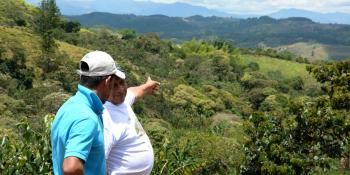CCAFS Scenarios Guide the Cambodian Climate Change Priorities Action Plan for Agriculture

Summary
The research was implemented in collaboration with the Environmental Change Institute, University of Oxford (ECI).
In Cambodia, agriculture plays an important role in poverty reduction, employment and national development goals, with 85% of the labour force still engaged in agriculture. However, the country’s agricultural sector is highly sensitive to the impacts of climate change, requiring urgent action. In response, the Cambodian government launched its 2014-2018 Climate Change Priorities Action Plan (CCPAP), to convert financial resources and key practices into focused action. CCPAP has a strong focus on climate-smart agriculture, which is to be incorporated at the sub-national and community level.
Expected outcomes include:
- Increased agricultural output
- Increased incomes and employment in the agri-business sector
- 10,000 farmers practicing climate resilient aquaculture
- Targeted agricultural extension services to 5 million farmers to increase their resilience
- Increased livestock production and decreased livestock mortality impacts of climate change
- Rehabilitation of 10,000 hectares of forest, to enhance biodiversity and carbon stocks
In 2013, CCAFS and partners from the UN Food and Agriculture Organisation (FAO), the United Nations Environment Program’s World Conservation Monitoring Centre (UNEP WCMC) and Vietnam’s Northern Mountainous Agriculture and Forestry Institute (NOMAFSI) developed participatory future scenarios for Southeast Asia. Based on future socio-economic developments and potential climate impacts, these scenarios were developed with inputs from 65 participants, including decision makers, researchers, private sector, and knowledge brokers from Cambodia, Vietnam, and Laos. These scenarios help stakeholders to test different policy and investment approaches to a variety of potential futures. The Cambodian Ministry of Agriculture, Forestry and Fisheries (MAFF) participated in the regional scenario development process and expressed interest in using these scenarios for priority setting in the CCPAP. However, this meant translating regional findings to the country level. Over the next nine months, an intense collaboration took place between the MAFF and CCAFS, and the CCAFS Scenarios team worked with the MAFF to help understand the implications of the Southeast Asia regional scenarios for Cambodia and to identify priorities for the CCPAP. The scenarios approach was used to create “safe spaces” to think freely about different policy futures and help answer key questions for decision makers. The collaboration culminated in the identification of priorities for the CCPAP as well as further collaborative work on policy and budget design.
Key facts
- Agriculture plays a key role in the Cambodian economy, but is threatened by climate change impacts.
- The Government of Cambodia launched CCPAP in response to climate change impacts, and with the goal of strengthening agricultural resilience.
- Scenario-guided planning and climate-smart agriculture were key components for the development CCPAP.
Lessons: key elements of success
- A scenarios approach allows policymakers to test policies and investments, and make priorities relating to different potential futures.
- The inclusion of diverse stakeholders within the scenarios development process allowed for them to join forces in addressing the challenges identified.
Further reading
- Future scenario development now part of Cambodia’s Action Plan for Agriculture
- Future Scenarios work in Cambodia
Related research outputs
- Vervoort JM, Thornton PK, Kristjanson P, Förch W, Ericksen PJ, Kok K, Ingram JSI, Herrero H, Palazzo A, Helfgott AES, Wilkinson A., Havlik P, Mason-D’Croz, D, Jost, C. 2014. Challenges to scenario-guided adaptive action on food security under climate change. Global Environmental Change: 28, 383-394.



